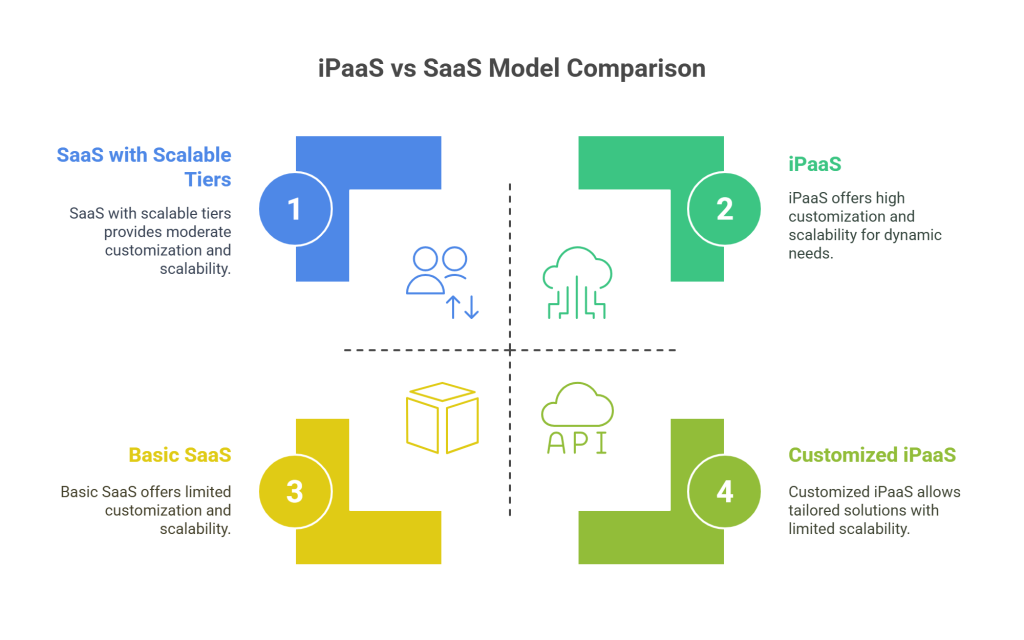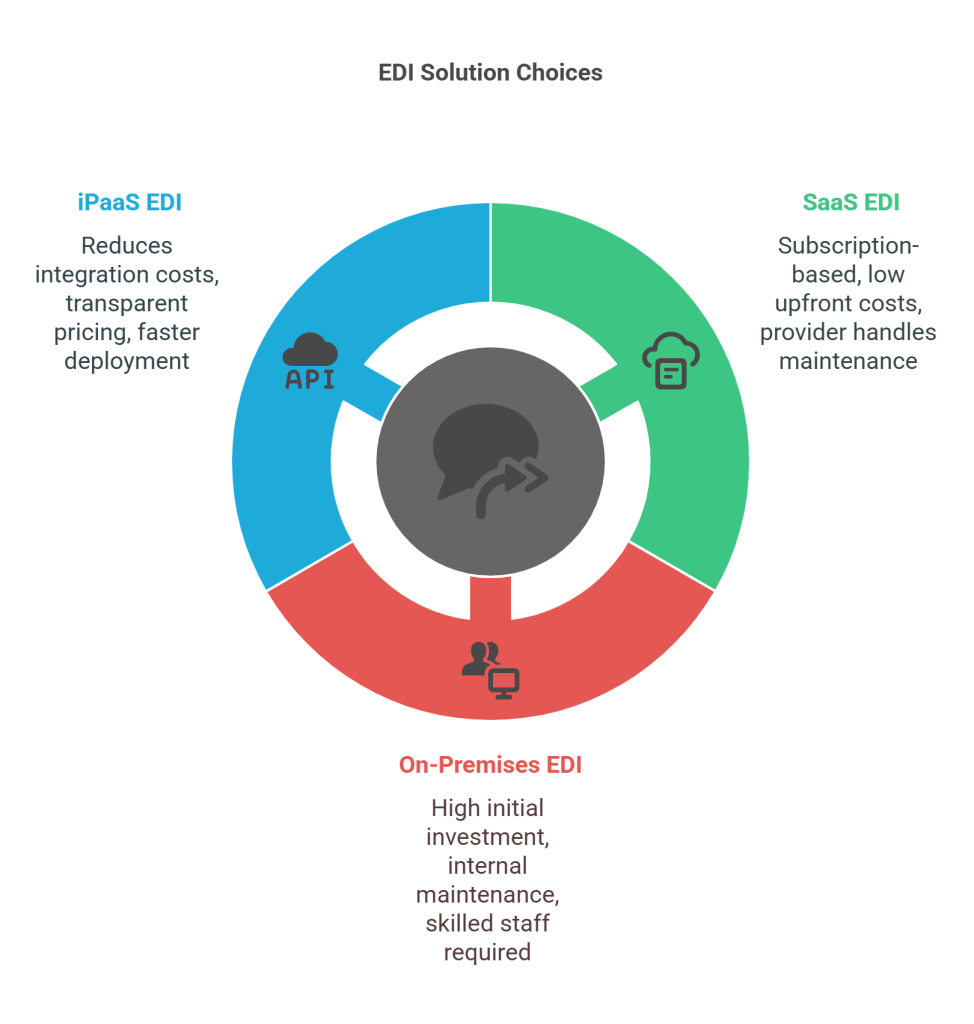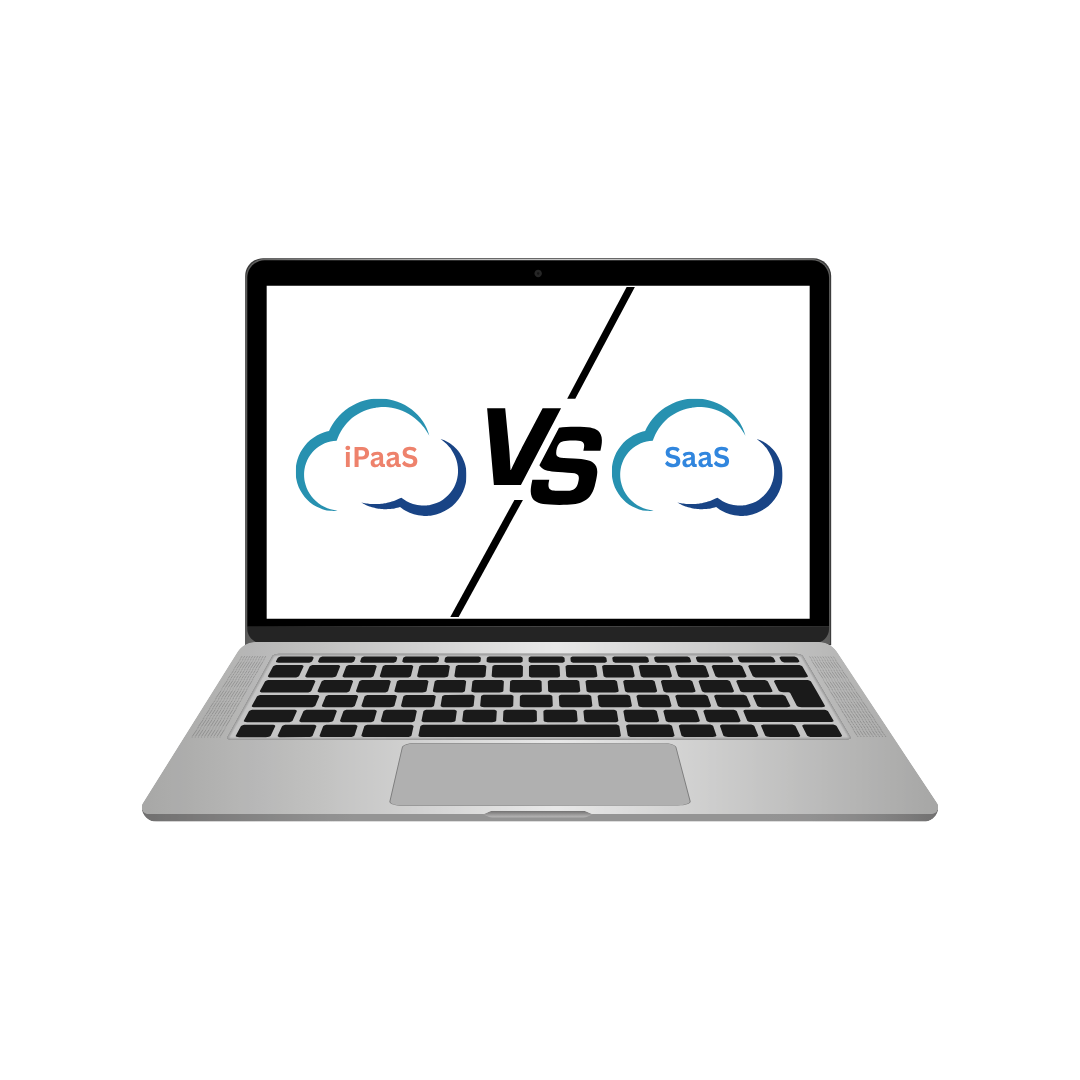Introduction
EDI Platform selection has become increasingly critical for businesses as the iPaaS market surpassed $1 billion for the first time and is expected to reach $7 billion by 2026. When managing multiple applications across your organization, choosing between iPaaS and SaaS delivery models can significantly impact your operational efficiency and bottom line.
Integration Platform as a Service (iPaaS) offers compelling advantages for businesses seeking a modern Electronic Data Interchange (EDI) platform. With iPaaS, we gain access to centralized management consoles that simplify the integration of diverse technologies, allowing for seamless communication and data exchange. Furthermore, these solutions enable real-time data integration and workflow automation, reducing manual intervention while enhancing business relationships.
As hybrid and remote working models become standard, the need for robust cloud integration solutions has never been more pressing. Whether your applications reside on premises or in the cloud, the right EDI platform can facilitate hybrid data flows, improve operational workflows, and potentially reduce costs associated with development and maintenance. In this comparison, we’ll examine both iPaaS and SaaS options to help you determine which EDI platform best aligns with your specific business requirements.
Understanding the Basics: iPaaS vs SaaS in EDI Context
Electronic Data Interchange (EDI) sits at the crossroads of two prominent cloud computing models: iPaaS and SaaS. As businesses increasingly shift toward digital transformation, understanding how these models function in the EDI context has become essential for making informed technology decisions. Let’s explore the fundamental differences between these approaches and how they shape modern EDI implementations.

Definition of iPaaS: Integration Platform as a Service
Integration Platform as a Service (iPaaS) is a cloud-based middleware solution that connects multiple systems, applications, and data sources through a centralized platform. At its core, iPaaS acts as a digital bridge between different technologies, enabling seamless data exchange across your business ecosystem. This next-gen middleware provides a user-friendly web interface where you can create, manage, and monitor all integrations and data flows from a single hub.
Unlike traditional integration methods, iPaaS platforms typically feature low-code or no-code interfaces that simplify the complex task of connecting disparate systems. These platforms excel at data transformation, allowing your business to map and convert information between different formats effortlessly. Beyond simple connections, iPaaS enables workflow automation and real-time data synchronization that enhances operational efficiency.
In the EDI context, iPaaS platforms specialize in transforming data between various EDI formats such as EDIFACT, ANSI X12, and XML. They offer pre-built connectors and templates for popular EDI standards, consequently reducing implementation time and effort. Additionally, iPaaS supports message validation to ensure exchanged data complies with specified standards and rules.
Definition of SaaS: Software as a Service
Software as a Service (SaaS) represents a software distribution model where applications are hosted by third-party providers and made accessible to users via the internet. Instead of downloading software directly onto your computers, SaaS offers a web-based delivery approach where vendors maintain the servers, databases, and code that comprise the application.
This model eliminates the need for companies to invest in expensive hardware infrastructure and ongoing maintenance. Rather than paying for perpetual licenses plus support fees, businesses simply subscribe through monthly or annual payment structures. SaaS applications can be accessed from any device with an internet connection and a web browser, making them particularly valuable for remote work environments.
According to recent research, 96% of companies are putting greater emphasis on integration solutions in response to changing business landscapes. Popular SaaS applications include CRM platforms like Salesforce, productivity suites like Microsoft Office 365, and marketing automation tools like HubSpot.
How EDI Platforms Fit into Both Models
EDI platforms have adapted to both delivery models, each offering distinct advantages for business operations. When EDI meets the cloud through SaaS, you gain self-service control over EDI functions via a more efficient and less expensive cloud model. This direct control enables your internal backend applications (ERP, TMS, CRM, WMS) to connect seamlessly with EDI-enabled trading partners.
SaaS EDI solutions establish communication systems that facilitate data transfer between your management system and the EDI solution, thereby enabling constant and automatic exchange of documents. These solutions are typically offered as managed services, with providers handling everything from installation to maintenance and updates.
Conversely, EDI iPaaS specializes in standardizing data exchange across various formats while offering extensive transformation capabilities. The Alumio iPaaS, for example, helps businesses integrate EDI, legacy systems, and cloud applications while standardizing data exchange across formats like JSON, CSV, XML, and EDIFACT.
For organizations using multiple SaaS applications, iPaaS becomes particularly valuable as it creates a central integration hub. This centralization allows businesses to automate processes such as order management, inventory synchronization, and customer data updates between their various SaaS tools, ultimately creating more fluid B2B data flows throughout revenue-critical business processes.
Core Functionalities of EDI iPaaS vs SaaS Platforms
Modern EDI platforms vary significantly in their core capabilities based on whether they follow an iPaaS or SaaS approach. Understanding these functional differences is crucial for selecting the right EDI solution that aligns with your business requirements.

Data Integration: Real-time vs Batch Processing
The primary distinction between iPaaS and SaaS EDI platforms lies in their data processing approaches. iPaaS solutions excel at real-time data integration, processing information almost instantaneously as it arrives. This immediate processing enables users to access up-to-date data across all connected applications and systems from one centralized location.
In contrast, SaaS EDI platforms often rely on batch processing, where data is collected and stored until either a certain threshold is reached or until the system is programmed to process it on a scheduled cadence. This approach creates inherent delays in data availability.
Real-time integration proves invaluable when immediacy is critical—such as tracking inventory levels or monitoring shipment status. Alternatively, batch processing remains beneficial for handling large volumes of orders (10,000+ daily) to prevent system overloads and reduce network congestion.
Workflow Automation Capabilities
Advanced iPaaS solutions provide a single, centralized platform for both technical and non-technical users to automate business processes. They offer developers robust capabilities for efficient development and execution of integration flows while simultaneously providing business teams with intuitive interfaces that help bridge knowledge gaps.
This democratization of integration tasks eliminates bottlenecks and accelerates time-to-value. Moreover, iPaaS platforms typically place no practical limits on the number of applications, flows, or data size, making them highly scalable.
SaaS workflow automation platforms, meanwhile, help streamline specific tasks but often have limited data integration functionality with restrictions on data volume, concurrent flows, and API calls that can result in performance issues at scale.
API Management and Prebuilt Connectors
iPaaS platforms typically feature:
- Extensive prebuilt connectors for popular EDI standards
- Comprehensive API lifecycle management tools
- Unified visibility across APIs organization-wide
Most modern EDI iPaaS solutions offer connections to over 1,000 trading partners through a single integration platform. From one dashboard, users can easily connect systems, automate workflows, and monitor all transactions with minimal effort.
Support for Hybrid and Cloud Environments
iPaaS solutions increasingly support hybrid integration architectures, connecting applications across both on-premises and cloud environments. This flexibility allows businesses to integrate legacy systems with modern cloud solutions effectively.
Specifically, advanced iPaaS providers enable real-time data synchronization between all integrated endpoints while automating data exchange based on conditions and triggers. In essence, this hybrid approach facilitates seamless communication between existing on-premises infrastructure and scalable cloud-based applications.
SaaS EDI platforms, limited in hybrid scenarios, still offer excellent cloud-to-cloud integration capabilities but may require additional middleware for connecting to legacy systems.
Benefits and Limitations: Which Model Offers What?
Choosing between iPaaS and SaaS for your EDI platform involves weighing several critical factors that directly impact operational efficiency and long-term success. Both models offer distinct advantages and limitations that deserve careful consideration.

Scalability: Elastic Cloud vs Fixed SaaS Tiers
iPaaS solutions provide superior scalability with no practical limits to the number of applications, flows, or data size. This elastic architecture allows businesses to adapt and scale integrations as needs evolve without extensive reconfiguration. Advanced iPaaS platforms can handle increasing data volumes seamlessly, enabling growth without compromising safety or performance.
In contrast, SaaS EDI platforms typically offer predetermined subscription tiers with specific limitations. Although they can scale based on user base growth, this often requires upgrading to more expensive packages when exceeding predefined thresholds.
Security and Compliance: Vendor vs User Responsibility
When exchanging sensitive information electronically, security isn’t optional—it’s essential. EDI security ensures transactions happen seamlessly through:
- Data encryption during transmission and storage
- User authentication to verify participant identities
- Secure networks to prevent breaches
Notably, SaaS vendors typically handle most security aspects, including updates, patches, and maintenance. However, this creates dependency on the provider’s security protocols. iPaaS solutions generally offer more robust security features with role-based access controls and comprehensive audit trails for better compliance management.
Customization and Flexibility
iPaaS platforms excel in offering tailored solutions for complex integration scenarios. They provide tools for business users to build and manage their own integrations, reducing IT bottlenecks. Advanced iPaaS solutions utilize AI, prebuilt connectors, and intuitive interfaces to bridge knowledge gaps between technical and non-technical users.
SaaS solutions, while user-friendly, often present customization limitations. Organizations with unique integration requirements may face challenges achieving full customization within SaaS frameworks.
Vendor Lock-in Risks
Vendor lock-in represents a significant concern for both models. With SaaS, organizations become dependent on providers for availability, performance, and support. If a provider experiences technical issues or discontinues service, it can disrupt access to critical applications.
Similarly, switching between iPaaS providers requires significant effort due to platform-specific configurations and customizations. This dependency potentially leads to technology stagnation, unanticipated costs, and accumulated technical debt if the chosen platform fails to evolve with market needs.
Cost, Deployment, and Maintenance Considerations
Financial considerations often determine the ultimate choice between iPaaS and SaaS EDI solutions. Beyond features and capabilities, understanding the cost structure and resource requirements helps businesses make informed decisions that align with both immediate budgets and long-term goals.

Initial Setup and Subscription Models
First and foremost, SaaS EDI platforms eliminate the need for upfront infrastructure investments. These solutions typically follow subscription-based billing models where businesses pay monthly or annual fees based on usage or selected features. Most EDI service providers charge by the number of kilo-characters within documents, with flexible pricing structures including pay-as-you-go and monthly or annual subscriptions.
In contrast, on-premises EDI solutions require substantial initial investments in hardware, software, and systems that follow regulatory standards.
Ongoing Maintenance and IT Involvement
Maintaining EDI systems demands ongoing attention and resources. SaaS EDI providers typically handle everything from setup, onboarding and maintenance to security and compliance concerns. This approach frees up internal resources and reduces IT burdens.
Conversely, on-premises solutions require organizations to employ skilled EDI programming staff with comprehensive knowledge of EDI standards, in-house systems, and communication protocols. Furthermore, companies must invest in ongoing training for staff to stay current with EDI processes, approaches, standards, and software.
Total Cost of Ownership Over Time
Over time, cloud-based EDI solutions generally offer lower total cost of ownership compared to on-premises alternatives. The monthly costs of cloud solutions are typically easier to accommodate in annual budgets than significant capital expenditures. Additionally, SaaS models avoid long-term contracts while iPaaS solutions reduce the time, effort, and costs associated with building and maintaining custom integrations.
Modern iPaaS platforms with low-code approaches further enhance ROI by reducing development time and maintenance costs. Their transparent pricing models help businesses accurately forecast expenses as they scale, thereby avoiding unexpected costs. Eventually, these solutions deliver faster time-to-value by enabling quicker deployment and reducing dependency on scarce IT resources.
Use Cases: When to Choose iPaaS or SaaS for EDI
Selecting the right EDI implementation approach depends largely on your specific business scenario and technical requirements. Different organizational contexts call for distinct solutions that align with your integration complexity, existing infrastructure, and industry demands.
EDI Integration for Multi-Cloud Environments
iPaaS solutions stand out for organizations operating across multiple cloud platforms. With iPaaS, businesses can integrate various SaaS applications and cloud services through a centralized hub. Essentially, iPaaS acts as a universal translator between different cloud environments, enabling seamless data flows without complex point-to-point connections. This approach eliminates the fragile network problems that arise when systems are connected directly to one another, creating a more resilient architecture.
Legacy System Modernization with iPaaS
For organizations seeking to update outdated technology without full replacement, iPaaS offers a practical path forward. Legacy systems still consume 60-80% of IT budgets simply to maintain operations. In contrast to complete system overhauls, iPaaS connects older foundations with modern applications, extending both functionality and lifespan of existing investments. This first integration approach lets businesses:
- Reduce costs by avoiding expensive full system replacements
- Gradually modernize while maintaining business continuity
- Automate previously manual processes between legacy and new systems
SaaS for Simple, Out-of-the-Box EDI Needs
When seeking straightforward EDI implementation with minimal technical overhead, SaaS EDI platforms offer compelling advantages. These solutions shine for organizations with standardized EDI requirements and limited customization needs. SaaS EDI provides ready-to-use functionality that works immediately, with vendors handling updates, maintenance, and security concerns.
Industry-Specific Scenarios: Retail, Logistics, Healthcare
Different industries benefit from specialized EDI implementations. In healthcare, EDI systems ensure all business systems speak the same language, providing a unified platform for automated order processing and inventory management. This standardization helps healthcare organizations move away from manual order management while supporting compliance with regulations. For retail and eCommerce, iPaaS automates order processing and inventory tracking, while manufacturers optimize supply chain operations and ERP integrations.
With the complexity of modern EDI requirements, many organizations turn to trusted providers like Commport Communications. A leading EDI provider in North America, offering various EDI platforms including integrated, cloud, and managed EDI services, they support over 6000 customers globally with solutions tailored to specific industry needs.
Conclusion
Selecting between iPaaS and SaaS for EDI implementation represents a critical decision that significantly impacts operational efficiency and long-term success. Throughout this comparison, we’ve examined how these two models differ fundamentally in their approach to data integration, automation capabilities, and deployment methods.
iPaaS clearly offers superior advantages for businesses with complex integration needs, especially those operating across multiple cloud environments or working to modernize legacy systems. The real-time processing, extensive customization options, and robust security features make iPaaS particularly valuable for organizations requiring flexible, scalable solutions. Additionally, the ability to handle hybrid environments positions iPaaS as the more versatile option for enterprises with diverse technology ecosystems.
Conversely, SaaS EDI platforms shine when simplicity and ease of implementation take priority. Businesses seeking straightforward, out-of-the-box functionality without extensive IT involvement will find SaaS solutions more aligned with their needs. The vendor-managed security and reduced maintenance responsibilities certainly create compelling advantages for organizations with limited technical resources.
Cost considerations ultimately play a decisive role in this decision. While SaaS solutions typically require lower initial investment through subscription-based models, iPaaS platforms often deliver greater long-term value through reduced integration development and maintenance costs. Therefore, businesses must carefully evaluate both immediate budget constraints and projected total ownership costs before committing to either approach.
Many organizations find themselves turning to trusted providers like Commport EDI Solutions, a leading EDI provider offering various EDI platforms including integrated, cloud, and managed EDI services that support over 6000 customers worldwide.
The ideal choice between iPaaS and SaaS depends largely on your specific business context, integration complexity, and growth trajectory. Smaller organizations with standardized EDI requirements might benefit from SaaS simplicity, whereas enterprises managing complex data flows across multiple systems would likely find iPaaS capabilities more suitable. Regardless of which model you select, ensuring alignment with your business objectives, technical capabilities, and industry requirements remains paramount for maximizing return on investment and driving operational excellence.
Commport EDI Solutions
Need Help? Download: Commport's EDI Buyers Guide
Unlock the full potential of your supply chain with our comprehensive EDI Buyer's Guide — your first step towards seamless, efficient, and error-free transactions
Frequently Asked Questions
iPaaS acts as a middleware for integrating multiple systems and applications, offering real-time data processing and extensive customization. SaaS EDI provides standalone functionality with simpler implementation but limited customization options and typically uses batch processing.
iPaaS enables businesses to connect older systems with modern applications, extending the functionality and lifespan of existing investments. This approach allows for gradual modernization while maintaining business continuity and automating processes between legacy and new systems.
SaaS EDI is ideal for organizations with straightforward, standardized EDI requirements and minimal customization needs. It offers ready-to-use functionality, reduced technical overhead, and vendor-managed maintenance and security, making it suitable for smaller businesses or those with limited IT resources.
iPaaS solutions offer elastic scalability with no practical limits on applications, data flows, or data size. SaaS EDI platforms typically have fixed tiers with predetermined limitations, requiring upgrades to more expensive packages as needs grow.
SaaS EDI solutions usually have lower upfront costs with subscription-based pricing, while iPaaS may require more initial investment but can offer lower total ownership costs over time. iPaaS platforms often reduce long-term integration development and maintenance expenses, especially for complex business environments.





